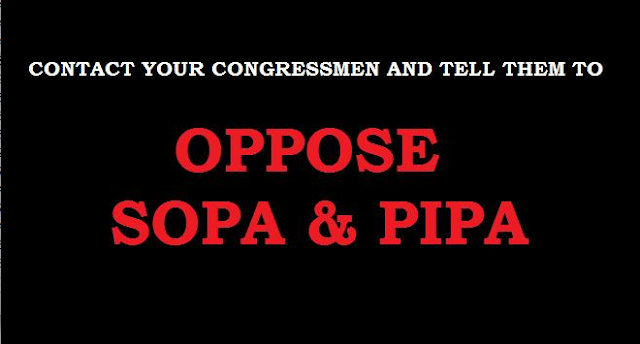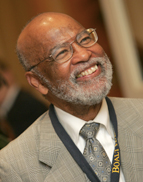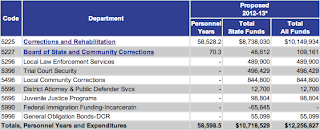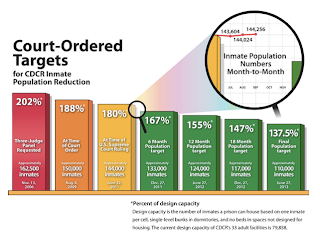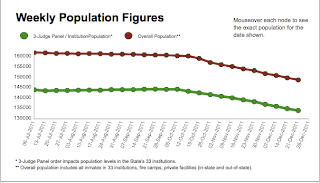BREAKING NEWS: Judge Henderson Orders End of Receivership
Today, Judge Thelton Henderson of the U.S. District Court expressed satisfaction with the improvements to prison health care, and ordered the federal Receiver, Clark Kelso, to report by april 30th when the receivership should end and whether the prison health care system will remain under federal oversight.
The Associated Press and the San Francisco Chronicle report:
The ruling marks an important milestone in a process that began nearly six years ago when the judge appointed a receiver to run California’s prison medical system after finding that an average of one inmate a week was dying of neglect or malpractice. He cited inmate overcrowding as the leading cause, but said in Tuesday’s order that conditions have improved.
He praised the better conditions throughout the system, particularly noted during inspections of medical facilities by the prison system’s independent inspector general.
“Significant progress has been made,” Henderson wrote, citing the receiver’s own report to the federal court last week. “While some critical work remains outstanding — most notably on construction issues — it is clear that many of the goals of the Receivership have been accomplished.”
While the Prison Law Office expressed concern that the Receivership’s end is premature, it might be a wise thing to start preparing for the shift in health care with the realignment. Counties will have to incur some of the costs for inmates’ health. But it’s worthwhile to remember that serious offenders, who usually serve more time, will remain in state prisons, and their lengthy prison sentences also implies that they age in prison and thus require expensive care.
———-
Many thanks to Brooke McCarthy for alerting me to this.
Correctional Budget 2012-2013
Governor Brown has released the proposed 2012-2013 California budget. The full details are here and the summary is here.
The report also lists the changes in programs that will ensue from the new budget. The main changes are as follows:
- The decrease in numbers of state inmates (from 163,152 to 132,167) and parolees (from 108,338 to 56,440) due to the realignment implies a decrease in state incarceration and parole budgets–a reduction of $453.3 million in 2011-12 and $1.1 billion in 2012-13.
- The outcome of Coleman v. Brown (the mental health side of the Plata case) required an increase of $34.3 million in 2011-12 and $27.3 million in 2012-13 in money allocated for mental health programs.
- Shifting responsibilities for juvenile offenders from the state level to the county level, which decreased the size of the state apparatus (1174 to 1149 inmates, 850 to 656 parolees) also implies a decrease in budget.
- The Estrella Correctional Facility has been cancelled, as there is no need for more beds.
- Expenditures for constructing the California Health Care Facility (CHCF) ($10.9 million) have been earmarked.
- Pharmaceutical Costs-The Budget includes $59.9 million for adult inmate pharmaceutical costs, primarily driven by an increase in drug prices.
- The budget includes an increase of $49 million in Community Corrections Performance Incentive Grants, which county probation departments receive if they demonstrate success in recidivism reduction.
- Another $8 million General Fund and $46.3 million are reduced to reflect the transfer of resources from the Corrections Standards Authority to the newly established Board of State and Community Corrections.
- FInally, the budget includes $101 million to restore a prior one-time reduction to rehabilitation services programs.
Happy New Year from the CCC Blog
And what a year it will be!
The Criminal Justice Realignment will figure prominently in our posts this year, with a special focus on the recent news regarding cuts that may endanger many juvenile programs. The most serious concern stemming from the cuts is that juveniles will be tried as adults. Some thoughts on the proper direction to take from Selena Teji and Emily Luhrs are posted here.
We’re also excited about the prospect of SAFE California’s initiative to end the death penalty in California in 2012, as well as a possible amendment of the Three Strikes Law to include only violent felonies.
Thank you, as always, for your readership, and stay with us by reading, commenting, and emailing.
California Prison Population Reduction: First Benchmark
December 27th was the first benchmark for reporting the progress in prison population reduction to the federal three-judge panel. CDCR’s press release on the matter reports:
As of December 14, the state’s 33 prisons held 134,804 inmates and were at 169.2 percent design capacity. Since October 1, the state prison inmate population has been dropping by an average of 933 inmates per week without the early release of any state prison inmates.
This comes fairly close to the 167 percent set by the federal panel, and CDCR is confident that it can meet the June 12 benchmark. More data and the graph are available here. Here are the actual numbers of inmates, measured weekly:
Make no mistake; 169.2 percent capacity is still very, very overcrowded. But it is, indeed, an improvement from the statistics that started off the litigation. What remains is to figure out how this has impacted county jail population. If the realignment has merely displaced people, or worse, increased their numbers elsewhere, the trend has not really been reversed, and we may be looking at a county-level version of Plata at some point in the future.
California Chief Justice Urges Reconsidering Death Penalty
In an interview in today’s Los Angeles Times, California Chief Justice Tani Cantil-Sakauye expressed her concerns about the death penalty and encouraged a public debate about its abolition.
“I don’t think it is working,” said Cantil-Sakauye, elevated from the Court of Appeal in Sacramento to the California Supreme Court by former Gov. Arnold Schwarzenegger. “It’s not effective. We know that.”
California’s death penalty requires “structural change, and we don’t have the money to create the kind of change that is needed,” she said. “Everyone is laboring under a staggering load.”
In response to a question, she said she supported capital punishment “only in the sense I apply the law and I believe the system is fair…. In that sense, yes.”
But the chief justice quickly reframed the question.
“I don’t know if the question is whether you believe in it anymore. I think the greater question is its effectiveness and given the choices we face in California, should we have a merit-based discussion on its effectiveness and costs?”
I think that is a terrific distinction between the judicial role of applying the law and the public and legislative law of reevaluating and changing it.
CDCR Publishes Decrowding Photos
Realignment: An Opportunity to Rethink Corrections
Some of the recent developments in realignment implementation, such as the request for jail expansion in Los Angeles County and Riverside’s shocking vote to charge inmates $140 per night for their jail stay, make one ponder whether counties really understand the idea behind realignment legislation.
AB 109 is not merely a jurisdictional change. The legislator intended an actual ideological shift in how California treats its inmates. A simple read of the bill’s text provides ample proof of that. The bill explicitly states that there would be a preference for intergration in the community, through programs like home detention. More importantly, it shifts inmates from state parole supervision to community postrelease, meant to provide better integration in the community. And to achieve that, community corrections partnerships have been formed in the counties and tasked with planning release in the context of a given community. Yes, the impetus for the realignment was fiscal, but there is ample evidence that this is intended to be a true paradigm shift. This story from Western Cities makes a great read in that respect.
If so, old-school thinking about construction and warehousing needs to be set aside and new models need to be considered. For example, why not reconsider felon disenfranchisement and extend voting rights to jailed inmates? As this ACLU guide explains, felons on parole currently cannot vote, but what about folks on community postrelease? Not only does it appear that these folks are not “on parole”, but rather under a probation-like regime, and can therefore vote, but it’s also sound public policy: There’s robust statistical proof that extending voting rights to people, and getting them involved in civic life, significantly contributes to recidivism reduction. Many countries in the world think nothing of providing inmates with voting rights as they do their time, not only upon release. Reintegration into society and reducing reoffending: Isn’t that what this is all about?
Here’s another example: As we discovered on our Food Deserts conference earlier this Fall, there are some beautiful prison projects that include community gardens and the like. The produce cannot, for various reasons, be consumed by CDCR inmates themselves. But why should local jail inmates not enjoy the fruits of their labor? And if, for some reason, that doesn’t make sense, why not combine their jail sentence with some landscaping work in urban gardens so that low-income families can get more fresh produce?
A third possible opportunity, borrowed from a suggestion Jonathan Simon made at a public talk in 2009, and which would become much more pertinent now: Given the concerns about infrastructure disasters and earthquakes in California, why not use jails and community postrelease programs to teach more inmates and released folks to save lives, homes, and businesses? It is an important function that we would all benefit from.
I truly hope that some counties will be able to think outside the box, set aside their appetite for construction and warehousing, and seize the realignment for what the legislators intended it to be: An opportunity to reverse the California correctional crisis.
Realignment: How Not To Do It, the Construction Version
Californians United for a Responsible Budget (CURB) are raising some serious concerns about rehabilitation implementation. They are circulating a petition against the Riverside County plan to charge inmates for their stay, and also spearheading an effort to stop a planned Los Angeles County jail expansion.
Under AB 900, counties have been invited to appeal for Phase II funding to increase their jail capacity. The list of counties is here; Los Angeles tops the large counties’ list.
One of the arguments usually thrown around in support of realignment is that even if the counties do a bad job at imprisonment, they cannot possibly be worse than the state. I’m beginning to think that, in some cases, that may not be true. There is no reason to believe that the state administration has all the punitive foolishness and the counties, all the recidivism-reducing wisdom. It is time for the counties to wake up and seriously commit to the goal of reducing confined population (and the expenses involved in confining it). Otherwise, a precious opportunity will be lost.
New Execution Procedures Deemed Unconstitutional
Those who have been following up on death penalty practices in California recall that, after a six-year hiatus, CDCR instated new proceedings. Now, a Marin County judge has found the new proceedings unconstitutional, which might mean a longer delay.
A judge on Friday threw out California’s new lethal-injection protocols, which have been six years in the making, because corrections officials failed to consider a one-drug execution method now in practice in other death penalty states.
The action by Marin County Superior Court Judge Faye D’Opal sends the state back to square one in redrafting procedures for lethal-injection executions. The death penalty has been on hold for six years in California after a federal court ruling deemed the previously used three-drug method unconstitutional because it might inflict pain amounting to cruel and unusual punishment.
D’Opal said in her 22-page ruling that the state’s failure to consider replacing the former execution practice with a single-injection method violated state law and ignored the courts’ and public criticism of the previous protocols.
Readers who are fed up with the new moves to tinker with the machinery of death, and who find themselves exasperated with the prospect of a CDCR appeal of Judge D’Opal’s ruling, might find the SAFE voter initiative to abolish the death penalty in 2012 an attractive option. It would certainly put an end to the quibble over technicalities.
If you are on the fence about this, perhaps the humonetarian argument from the L.A. Times story will convince you:
A three-year study published earlier this year by a federal judge and a Loyola Law School professor reported that taxpayers have spent $4 billion to carry out 13 executions since capital punishment was reinstated in 1978, and that it costs at least $184 million a year to maintain death row and the capital defense system.

